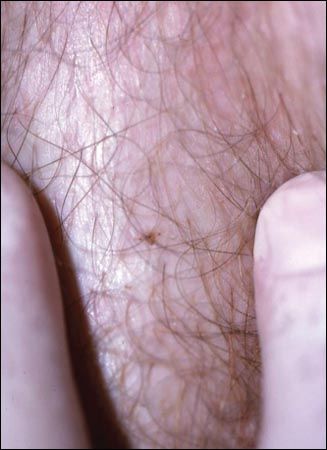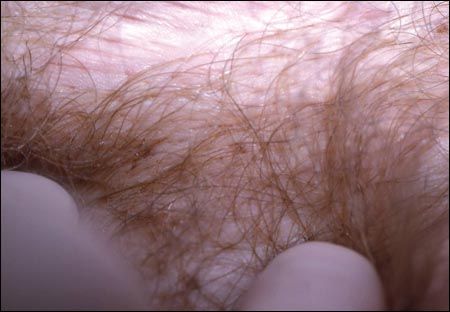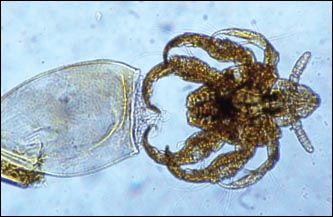- Clinical Technology
- Adult Immunization
- Hepatology
- Pediatric Immunization
- Screening
- Psychiatry
- Allergy
- Women's Health
- Cardiology
- Pediatrics
- Dermatology
- Endocrinology
- Pain Management
- Gastroenterology
- Infectious Disease
- Obesity Medicine
- Rheumatology
- Nephrology
- Neurology
- Pulmonology
What’s responsible for pubic itching in this patient?
A 32-year-old woman presents for evaluation of itching in the pubic area.

Case 2:
A 32-year-old woman presents for evaluation of itching in the pubic area.
Answer on Next Page

Case 2: Pubic lice infestation

The primary symptom of pubic lice infestation, D, or pediculosis pubis, is pruritus in the affected areas. Another clinical feature of infestation is the presence of maculae cerulea, which result from the bites of the lice. Excoriations are common. Inguinal lymphadenopathy and axillary lymphadenopathy have been associated with pediculosis pubis.
The pubic louse (Pthirus pubis) received the nickname "crab" because of its short, broad body (0.8 to 1.2 mm) and large front claws, which give it a crablike appearance. The large claws enable the lice to grasp the coarse hairs in the groin, perianal, and axillary areas. Heavy infestation with P pubis can also involve the eyelashes, eyebrows, facial hair and, occasionally, the periphery of the scalp.
Poll Results
Online Poll
Powered By
WebsiteGear
: Requires Javascript Enabled On Your Browser.
The average life cycle of P pubis is 35 days; the lice cannot survive away from the human host for more than 1 day. The average female pubic louse lays 1 or 2 ova (nits) per day. The nit attaches to the base of the hair shaft or to fibers of clothing with a strong, highly insoluble cement. Nits do not hatch at temperatures lower than 22°C (71.6°F), but they can remain alive for as long as 1 month away from the body (ie, on fomites, such as clothing and towels).
Pediculicides are the mainstay of treatment. The pyrethroids are neurotoxic to lice. They are not very effective against nits; however, they do have a residual effect. Permethrin is usually the first line of treatment, although resistance is increasingly common. Permethrin is available as a 1% solution (Nix) and as a 5% solution (Elimite); a formulation of pyrethrin and piperonyl butoxide (Rid) is also available. Lotions appear to be more effective than shampoos because of their increased contact time with the skin and hair of affected areas. In addition, the patient's clothes, bed sheets, and towels should be washed in water at a temperature of at least 49°C (120°F) for a minimum of 30 minutes.
Seborrhea and psoriasis feature more scale than is seen in this patient. Bacterial folliculitis is usually tender rather than pruritic.
